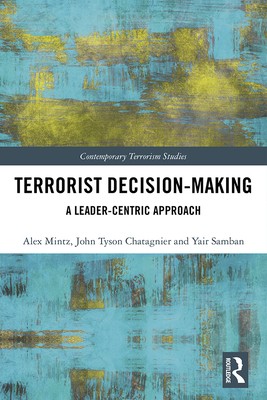
- We will send in 10–14 business days.
- Author: Alex Mintz
- Publisher: Routledge
- ISBN-10: 036719628X
- ISBN-13: 9780367196288
- Format: 15.5 x 23.6 x 2 cm, kieti viršeliai
- Language: English
- SAVE -10% with code: EXTRA
Reviews
Description
This book analyzes a series of decisions by leaders of three major terrorist organizations and identifies a unique Decision DNA for each of them.
The authors use the Applied Decision Analysis methodology to examine organizational and operational decisions made by the leaders of three major groups: Hezbollah (Hassan Nasrallah), Hamas (Khaled Mashal), and al-Qaeda (Osama bin Laden). Decisions that were of critical importance to each organization are identified and anaylzed, to uncover the particular decision rule employed by the leader in question and to establish their Decision DNA. A Decision DNA is unique to each leader and can be used to explain previous decisions or predict future choices. The authors demonstrate that the findings presented can be used to promote effective counterterrorism measures, and they provide a series of policy implications that arise from their examination of each leader.
This book will be of much interest to students of terrorist studies, political violence, security studies, and Middle Eastern politics.
EXTRA 10 % discount with code: EXTRA
The promotion ends in 23d.01:21:09
The discount code is valid when purchasing from 10 €. Discounts do not stack.
- Author: Alex Mintz
- Publisher: Routledge
- ISBN-10: 036719628X
- ISBN-13: 9780367196288
- Format: 15.5 x 23.6 x 2 cm, kieti viršeliai
- Language: English English
This book analyzes a series of decisions by leaders of three major terrorist organizations and identifies a unique Decision DNA for each of them.
The authors use the Applied Decision Analysis methodology to examine organizational and operational decisions made by the leaders of three major groups: Hezbollah (Hassan Nasrallah), Hamas (Khaled Mashal), and al-Qaeda (Osama bin Laden). Decisions that were of critical importance to each organization are identified and anaylzed, to uncover the particular decision rule employed by the leader in question and to establish their Decision DNA. A Decision DNA is unique to each leader and can be used to explain previous decisions or predict future choices. The authors demonstrate that the findings presented can be used to promote effective counterterrorism measures, and they provide a series of policy implications that arise from their examination of each leader.
This book will be of much interest to students of terrorist studies, political violence, security studies, and Middle Eastern politics.


Reviews